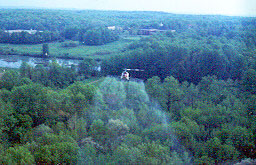
The Forest Pest Management program serves the citizens of Maryland by protecting the rural and urban forest tree resources from adverse effects of insects, diseases and other pests through environmentally sound pest management. With over one third of Maryland’s land area covered by forest, the goal of the Forest Pest Management program is to protect high value forest and landscape trees in urban and rural areas from losses due to insects and disease.
There are several forest pests, present and on the horizon, that pose a significant threat to Maryland’s forest resources. These pests are monitored through the Cooperative Forest Health Program involving the U.S. Forest Service, MD Department of Agriculture and MD Department of Natural Resources. The main objective of this program is the initial detection, identification and evaluation of spread and potential damage and loss caused by both native and invasive forest pests. This is accomplished through a variety of trapping and field surveys including following up on reports from forest owners, managers or forest visitors. Once identified the program works with State and Private Forest owners and managers to recommend and help implement best pest management practices to eradicate or suppress the pests or manage their resources to minimize loss. Currently we are monitoring Southern Pine Beetle, Sirex woodwasp and Walnut Twig Beetle the vector of Thousand Canker Disease in walnut.
The Forest Pest Management program also conducts and oversees several statewide pest suppression projects. The spongy moth, a significant hardwood defoliator, is suppressed through a cooperative aerial spray project involving Federal, State and Local funding. The Hemlock Woolly, a damaging pest of hemlock, is suppressed through the use of systemic insecticides involving Federal and State funding.
Field activities are conducted from our four regional field office in Cumberland, Easton, Street, Frederick and our headquaters in Annapolis.